Movies
(short list)
TV shows
Music Videos
Books
Comics
Documents
Links
Where to buy
Thwarting a Straitjacket Escape
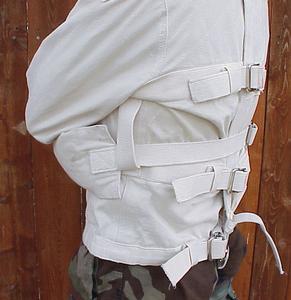 mvc-387x.jpg
mvc-387x.jpg

Introductory note:
This was initially constructed from an e-mail to Harold & Bob who were expecting
a visit from Max Cita.
Max Cita had issued them a challenge that he could get
out of one of his Psycho straitjackets.
As of today (Febuaray 24, 2001), several months later,
it looks like his visit is at least several months out. So Max may not be in for
as big a surprise when he arrives (assuming he reads this).
It has also become the combined work of Don and myself. I have provided
most of the details and he has made the reading more fun.
Oh, please don't tell Max about this page until he visits Harold and Bob for
his challenge escape. (Though I'm personally not convinced he
actually wants win the straitjacket challenge anyway.)
As of Sunday, December 14 at 6:25 AM
() this page has been accessed 60752 times. (zeroed 2/24/2001.)

They Check In, But They Don't Check Out:
Thwarting a Straitjacket Escape
So you're in the audience at a magic performance, and you're chosen to help
put the performer in a straitjacket. Would it be it fair game to try to foil
the escape?
In answer, I'd like to ask if you think it's fair game to fool an
inexperienced mark with a gaffed--tricked--jacket. If you're on the
committee charged with making sure the escape is legitimate, are you under
any kind of obligation to collude with the performer to carry out an
intended deception? What's your obligation to the audience: to help the
performer pull off a smooth show, or to give them a proper challenge?
If it's only the performer's pride that's at risk, I'd do what I could to be
sure the performer gets a thorough challenge. Your escape artist might
disagree.
In order to take suitable countermeasures, you need to be able to anticipate
your challengee's options, tactics, and strategies. So here let me explain
how I go about getting myself out.
My approach depends on so many contingencies--the particulars of the
jacket's construction, how it's been applied, and what's available in the
immediate environment--that it's hard to give a simple explanation. Whatever
choice I take--and, though it may not look like it when I'm all strapped in,
I still have a range of options--this activity is definitely not
one-size-fits-all.
My first objective is usually to free my arms. I can generally work up
enough
slack to slide my arms over my head if there aren't any arm loops to secure
them to my torso. To get the slack I need, I may get down on the floor and
thrash about-- audiences eat this up--so that I can push my elbows into the
floor. By a happy accident, I'm so built--thin and long-armed--that I can
generally still get my arms over my head even when the jacket's strapped so
tightly that I have trouble breathing. Trying to work the sleeves down under
my butt has never gotten me anywhere. And here let me stress that this is
due to an accident of anatomy that your contender may not share.
If there are arm loops securing the sleeves, then I'll try to get my fingers
to the buckle connecting the sleeve ends. I'll slip one arm into its sleeve
as deeply as I can manage while withdrawing the other. (This is also a
useful maneuver for shifting slack from one arm to the other, as is
frequently required.) Then I'll try to work the sleeve buckle into reach so
I can work on it through the sleeve. Here, too, by pressing my elbows
against the floor I can gain useful slack.
Next I'll try to work the sleeve buckle against something. Chair legs and
backs, table edges, door knobs, coat hooks, drawer pulls, half-open drawers,
and cell bars: I've put them all to good use. If my challenger is foolish
enough to leave a mirror around, it's a lot easier for me to follow what's
going on behind my back.
In working on a buckle, my first goal is to get the strap out of the keeper.
Now the going can get slow and tedious, and often exhausting and painful. It
may take an hour--or even longer--before I see clear signs of progress. At
this stage it can come to seem easier to give up. But then again, I tell
myself, all trussed up like this, can you think of any better way to spend
your time?
What am I doing all this time? I'm trying to snag a little section of the
strap on something so I can give it a pull. This will withdraw a bit of the
strap's tail through the keeper back toward the buckle, where the slack will
form a little loop. Then I'll try to repeat the operation, to enlarge the
loop, and continue till I've pulled the whole tail out of the keeper. With a
friction buckle, the rest is easy.
A roller buckle at this point still presents a challenge. I still need to
get the tongue out of the hole in the strap, and I'll do this by pulling on
the end of the strap. I'll try to close a door or a drawer on the end of
the strap. This gives me an opportunity to pull the strap free of the pin.
Of course, if the end of the strap gets jammed in a doorframe and I can't
get it free, it's also given me the opportunity to get really stuck.
If I can't seem to make any progress on the sleeve buckle, I'll try working
on the buckles holding the top two back straps. If I can work the top buckle
free and loosen the second one, I should be able to pull my arms out of the
jacket.
Some people can manage to draw their arms out of the sleeves into the body
of the jacket. I've never succeeded in doing this myself, you understand,
but some people can. Having short arms would help. So would a tricked or
poorly constructed jacket.
Which brings me back to your challenge. Most magicians and escape artists
use a gaffed or tricked straitjacket. How do you spot one? How might it be
tricked?
In many gaffed jackets, one or both sleeve straps can surreptitiously be
drawn a few inches into the sleeve from inside, before the sleeve straps are
fastened. Once the sleeves are secured, those extra inches of slack can make
the difference between an easy escape and a real challenge.
To give the jacket a proper inspection:
- Make sure that the straps at the ends of the sleeves are really attached
to the sleeve the way they appear. You shouldn't be able to pull out either
strap.
- Check both straps. Only one needs to be tricked.
- Now try to push/slide EACH sleeve-strap into its sleeve. Again, only one
needs to be tricked. In the absence of arm loops, three inches of slack can
make for an easy escape.
- Turn both sleeves inside out. Look closely and carefully at each.
- Be especially suspicious if there are no loops to pass the sleeves
through, to keep the prisoner from working the arms up over the head or down
under the legs.
- If roller buckles are used, the buckle holes should begin just beyond
where the straps are attached--otherwise, you may have no choice but to
leave the performer some slack.
- In an honest straitjacket, the sleeves and shoulders should fit snugly
but comfortably. There shouldn't be a lot of extra material. Some gaffed
jackets have sleeves that are extra-wide, especially in the shoulders. This
can enable the performer to draw the arms out of the sleeves even if they're
tightly strapped down. As a challenger, there isn't a lot you can do about
this, except to point out how easy this makes it to escape, and maybe to
demonstrate how.
- The seams of a legitimate straitjacket will be double- or triple-sewn,
and the most critical will be reinforced with webbing. If you don't see
this, look extra hard for the gaff. Likewise if there's no crotch strap.
Now that you know how a real escape artist might proceed, and how to spot a
tricked jacket, let's talk about how to apply a real straitjacket in a real
challenge. Most of my experience has been with real straitjackets made for
institutional use, not tricked straitjackets designed to make things easy
on-stage.
Some institutional straitjackets are fairly easily escaped, if they aren't
correctly applied. For example, my first time in a standard Humane Restraint
jacket, it took me less than two minutes to get out. With a very small
change in how it was put on, I might still be there today.
Today four North American companies manufacture straitjackets not designed
for stage performance:
- Humane Restraint jackets are by far the easiest to escape. There are no
loops to retain the arms, which can be worked up over the head. (Unless, of
course, before fastening it you run a sleeve strap under one of the back
straps. That would give someone a much greater challenge.) Some of their
jackets also don't come with a crotch strap. Humane Restraint also makes a
gaffed model specifically for the magic trade.
- The standard jacket from Posey can be very challenging. These have two
or three loops to keep the would-be escapee from working the arms up over
the head. They also come equipped with a crotch strap.
- The Psycho model straitjacket from Caught-in-the-Act is the greatest
possible challenge to the serious escape artist.
- The Fetters "Historical Pattern" in all canvas or canvas with leather
reinforcement available from Mister S. (San Francisco and Los Angles)
also presents a formidable challenge.
Before we begin, you should understand that a properly applied straitjacket
should be snug but NOT tight. Tightness beyond what's strictly necessary can
turn a restraint into a true instrument of torture. It can cause permanent
damage. Most to the point, it won't help keep someone restrained, but will
reduce the length of time it can be tolerated. (Yes, straitjackets have been used
for both punishment and torture. See
Jack London's Star
Rover.)
So the following tells you just what steps I'd take in challenging a highly
skilled escape artist. This would tax the skills of a better escape artist
than I --in this department, my physical skills are rather modest.
Some of what follows may seem tediously technical. Believe me, reading it
isn't half as tedious as performing an escape. But remember the saying: the
Devil (or is it the Divinity?) is in the details.
Note: several of these measures might not be considered quite
kosher--particularly by your would-be escape artist. But as they say, all's
fair...
- If this is a stage escape, from the very first try to get the audience
on your side. Some performers show an unconscious streak of arrogance. Where
applicable, use it to your best advantage. People hate a bully, and love to
root for the underdog. Play the scene accordingly. The crowd can get the
performer to accept conditions they'd never accept voluntarily.
Oh, that's good. You catch on quickly.
- Bring the most difficult jacket you can find. If at all possible, use a
Psycho model straitjacket from Caught-in-the-Act--it's positively
diabolical.
- As I've explained above, a fixed point--a coat hook, a door handle, the
knobs on a brass bedstead--is invaluable in working the straps loose. So if
at all possible, prepare in advance the room where the escape attempt will
be held. Remove anything that might offer any assistance, starting with the
furniture. Obviously this is impossible on-stage, but may be possible in a
private challenge. On-stage, you might tether a foot where any potential help
is beyond reach.
- Videotape and/or watch successive escape attempts -- this is invaluable,
if you can arrange it. If you know how your escape artist gets out you can
arrange suitable countermeasures. If you're going to get more than one
chance, first put the jacket on the standard way and watch what happens. If
you only get one try, I'd use every trick in my book.
- Gloves or mitts worn under the jacket will help control those tricky
fingers. You might also tape the fingers together and the thumb down.
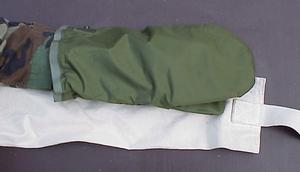 mvc-380x.jpg
mvc-380x.jpg
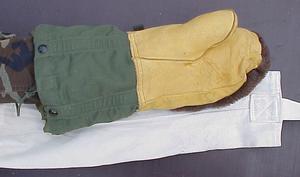 mvc-381x.jpg
mvc-381x.jpg
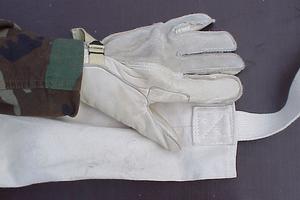 mvc-382x.jpg
mvc-382x.jpg
- Depending on the straitjacket's construction and fit, a bulky jacket
worn underneath--a flak jacket is perfect--can make escape much more
challenging. It will make the sleeves and body fit much more snugly. For
me--skinny as I am--it makes most maneuvers tremendously more difficult. And
if by some mischance your escape artist should manage to work an arm out of
a sleeve, it imposes an extra layer between those busy fingers and any
buckle.
 mvc-384x.jpg
mvc-384x.jpg
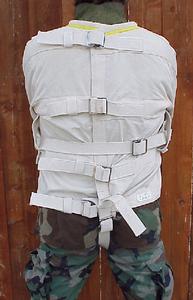 mvc-386x.jpg
mvc-386x.jpg
In addition, the extra insulation makes the work just that much sweatier.
The heat alone can cut down on the amount of work your performer can
accomplish in a given time. In the course of a routine escape I will
regularly soak through both a double layer tee-shirt and the straitjacket.
- Buckle a short strap about each wrist. Locking Humane Restraint cuffs
are even better. These will make it much harder (read: impossible) to draw
the arms out of the sleeves. Over the strait jacket sleeves is best, but
even inside the sleeves they'll make escape more difficult. This might not
be seen as fair play.
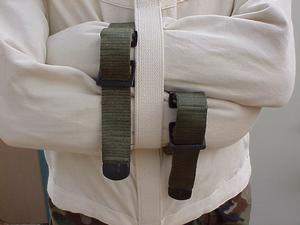 mvc-388x.jpg
mvc-388x.jpg
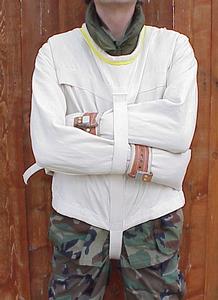 mvc-389x.jpg
mvc-389x.jpg
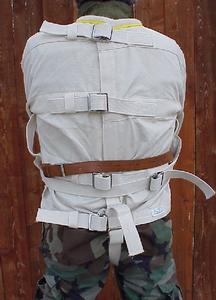 mvc-390x.jpg
mvc-390x.jpg
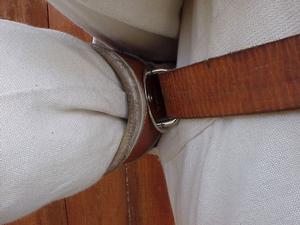 mvc-391x.jpg
mvc-391x.jpg
- Don't forget to secure the crotch straps. It's hard to do this before an
audience without looking like a bully, and your contender will make the most
of it, but it's got to be done. If your contender is male, do watch out for
the family jewels, but don't let this make you squeamish. Without this step,
the whole thing can be shrugged off like a sweater. (Well, almost.) Pass the
crotch strap to one side, and you can make it as tight as you like without
causing discomfort, except perhaps to the spine and shoulders.
With my build, I can work a leg through a Posey's single crotch strap. If
there are two crotch straps, I suspect you could foil this move by knotting
them together where they cross. Do make sure the knot falls somewhere
painless.
- When crossing the arms, be sure to interlock them properly. Don't just
place one on top of the other. Pass one sleeve over the opposite bicep. Then
take the end of the other sleeve over the forearm of the first and under the
bicep. If there's no front loop, as with Humane Restraint jackets, this is a
fairly effective substitute.
- If there's no front loop on the jacket--it holds the arms to the
chest--don't forget to run the arm strap under one of the back straps. And
before securing it, work hard to remove every last bit of slack. A helper
would make this is much easier, but would cost you any claim to underdog
status. Instead, stand hip-to-hip with your escape artist with their near
elbow against you. With one hand pull the far elbow toward you while with
the other hand you draw the sleeve strap taut. Now give 'em a good big bear
hug while doing this, and draw that strap tighter--if it doesn't open you to
charges of sexual harassment.
Yes, that's very good. Now let 'em push those elbows against the floor as
hard as they can. You've already taken up that slack.
- Bear this in mind: When you go to saddle a horse, sometimes the beast
will take a deep silent surreptitious breath and hold it while you're trying
to tighten the cinch. You turn away, and the next thing you know, the
saddle hanging under the creature's belly, while he give you an innocent
look as if to say, "Who, me?" When someone goes to tighten either the back
straps or the sleeve straps on a straitjacket, I'll try to steal some slack
just like that wily animal.
And whether you're contending with a horse or a two-legged critter, the
solution is the same: a sudden knee in the ribs. Of course, unless you're
auditioning for a spot on TV wrestling (and even then you'd better be trying
out for the role of "Dark Invader"), never try this on-stage. Or, if you do,
be prepared for the audience response.
- Now buckle the sleeve strap the "very hard way". Remember how, with a
lot of hard, tedious work, I can get the strap end free of the keeper
without using my hands, if the buckle is fastened the regular way?
Refer to my buckle page at
http://sj.blacksteel.com/buckle/. It shows various ways of fastening the
friction buckle currently sewn on a Posey straitjacket. All are much harder
to undo from within than the standard way.
To secure the buckles on a Posey or a canvas straitjacket from Caught-in-the-Act,
pass the strap:
- through the toothed opening
- past and over the keeper
- through the last slot on the buckle
- back up under the strap (next to the pivot pin)
- and back through the toothed opening. It will come out UNDER the
incoming strap.
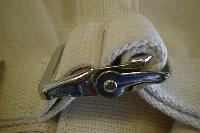 640x426 image
640x426 image
- Last, tie a knot in the end of the strap.
Again, referring to photos on the buckle page should help make this clear.
Two additional steps for the compulsively thorough --
- Tie the buckle to each of the arm loops with a cord or leather thong.
This is devilish. Now the sleeves can't be shifted at all. And even if
somehow the buckle gets undone, one arm is still secure.
- Wrap the buckle with a piece of cloth (to keep it clean) and then with
duct tape. It is also easy to make buckle covers with Velcro-closing strips.
In Jim Stewart's experience these
super-efficient inhibitors and something to be reckoned with.
- If you like, in addition to the arm straps, you can secure any or all of
the other straps as per the above.
I'd rank the buckles in the following order of importance:
- The sleeve strap.
- The back strap just below the arms.
- The topmost back strap.
- The crotch strap(s).
- The waist strap (depending on the fit).
- The lowest back strap.
(Note: Caught-in-the-Act supplies an extra strap to go over the arms. I
wouldn't even bother with it. It looks nice but it hurts the arms, and I
don't think it makes a challenge any more difficult. Better yet, take the
strap out of the arm keepers and just put it around the chest just under
the shoulders. This foils any attempt to draw arms out of sleeves and restricts
breathing slightly which makes all activity harder work.)
Tie the top two back strap ends together with a ring bend or water knot.
( insert link here)
Any collar is potentially hazardous. For safety reasons, it's important
to monitor the would-be escapee at all times. Choking isn't the only
danger--there are pressure points in the neck that can induce loss of
consciousness, and in rare cases cardiac arrest. Jackets designed for
institutional use, quite properly placing safety first, have very wide neck
openings.
I've described above how I sometimes work one arm deeply into the sleeve
while withdrawing the other as far as I can. This shifts the body of the
jacket to one side and moves one side of the collar over against the neck. A
snug collar will reduce the amount of play available. It can also asphyxiate
the maniacally determined. The Psyco design--incorporating a tall snug
collar--assumes that you're only just crazy enough to get yourself into a
mess like this but not outright suicidal. In certain cases of testosterone
poisoning, this may not be a safe assumption.
With this caution in mind, I'll tell you that locking the collar on--this
assumes that your jacket comes equipped with locking buckles--will make a
complete escape next to impossible. Even if your escapee manages to free the
arms, the darned thing will still dangle frustratingly about the neck.
Your contender isn't likely to be any too eager to consent to this one.
But if you can get the audience on your side, they may not give 'em much
choice.
Secure the arms with pinion straps, as follows: Fasten a pair of leather
cuffs (Humane Restraint cuffs are perfect) or broad heavy straps about the
biceps, just above the elbows. Then connect them behind the back by rope or
strap, and make things snug without impairing circulation. This measure
alone will make almost any strait jacket virtually escape-proof.
A simple rope harness can be used to hold the jacket sleeves next to the
body. Under an arm, over the FAR shoulder, back under starting arm, across
chest/back, under other arm, over the FAR shoulder, back under the arm, and
tie it off. For safety, never around the neck! The knot should be out of
reach around back. Yes, of course, you can tie the ends off to some fixed
point. I can see you're getting the hang of this. But first you might want
to read the next step.
This is an effective countermeasure when you have no control over the
challenge site. It's likely to be considered foul play--and it isn't
something I'd ever let you do to me, no sirree! But just in case it's
allowed--and again, if you can get the audience with you, you may be able to
shame your contender into consenting--equip yourself in advance with a
modified duffel bag. Use a heavy canvas one like a laundry sack, with the
opening at the end and not down the side. Cut an opening in the circular
bottom to accommodate your contender's head. The hole should be slightly
offset, like the neck of a t-shirt, and on axis with the closing. Slip it
over your contender's head, straitjacket and all, till the head emerges and
the bag covers everything but the head and the legs. Now, if you're nice,
you'll clip it closed between the legs and lock the shoulder strap around
something fixed. If you want to be nasty, before you close it stuff the
duffel bag with laundry till it's full, and make sure you secure that crotch
closing with a lock.
Now, let 'em rub those buckles against whatever they can find. Let 'em do it
to their heart's content. It won't do 'em a lick of good.
If you can get your contender to consent--and this, too, might be seen
as a dirty trick-- tie 'em down to a backboard, ladder, litter, gurney, cot,
stretcher, or chain-link fence. Even an eight-foot-long 2-by-4 board will
do. If this isn't acceptable, strap or tie the legs together at the ankles
and just above the knees.
One more measure that might not be considered legit: A blindfold or hood
will impair your contender's ability to see what needs to be done. In
addition, it's unexpectedly and disruptively disorienting. Not to mention
intimidating.
And now, while your would-be escape artist flops about cursing on the floor
behind you, don't just stand there. Take your modest bow. You've earned it.
Congratulations!
Just don't ever turn up in the audience at any show of mine.
You may want to look at a
PBS page on Houdini's straitjacket escapes.
Please mail me your comments and suggestions at
louis@sj.blacksteel.com. Escape artists willing to share secrets are
especially welcome!
Thanks, Yossie, for hosting my
page at blacksteel.com
Movies
(short list)
TV shows
Music Videos
Books
Comics
Documents
Links
Where to buy
 mvc-387x.jpg
mvc-387x.jpg
![]()
 mvc-380x.jpg
mvc-380x.jpg
 mvc-381x.jpg
mvc-381x.jpg
 mvc-382x.jpg
mvc-382x.jpg
 mvc-384x.jpg
mvc-384x.jpg
 mvc-386x.jpg
mvc-386x.jpg
 mvc-388x.jpg
mvc-388x.jpg
 mvc-389x.jpg
mvc-389x.jpg
 mvc-390x.jpg
mvc-390x.jpg
 mvc-391x.jpg
mvc-391x.jpg
 640x426 image
640x426 image